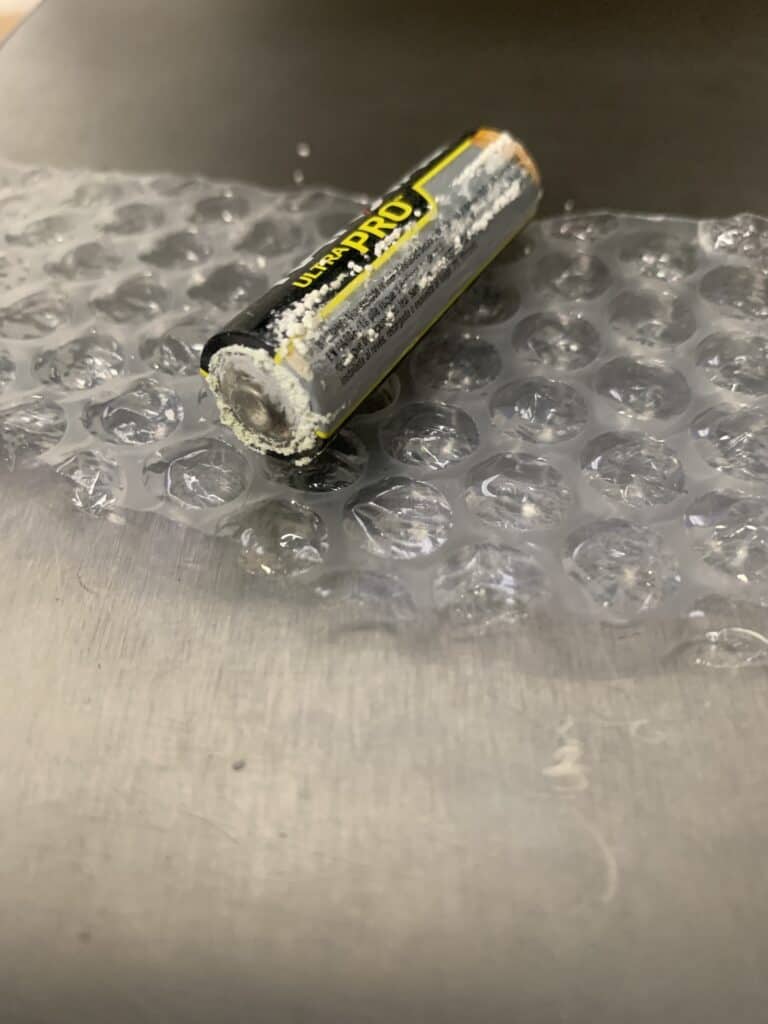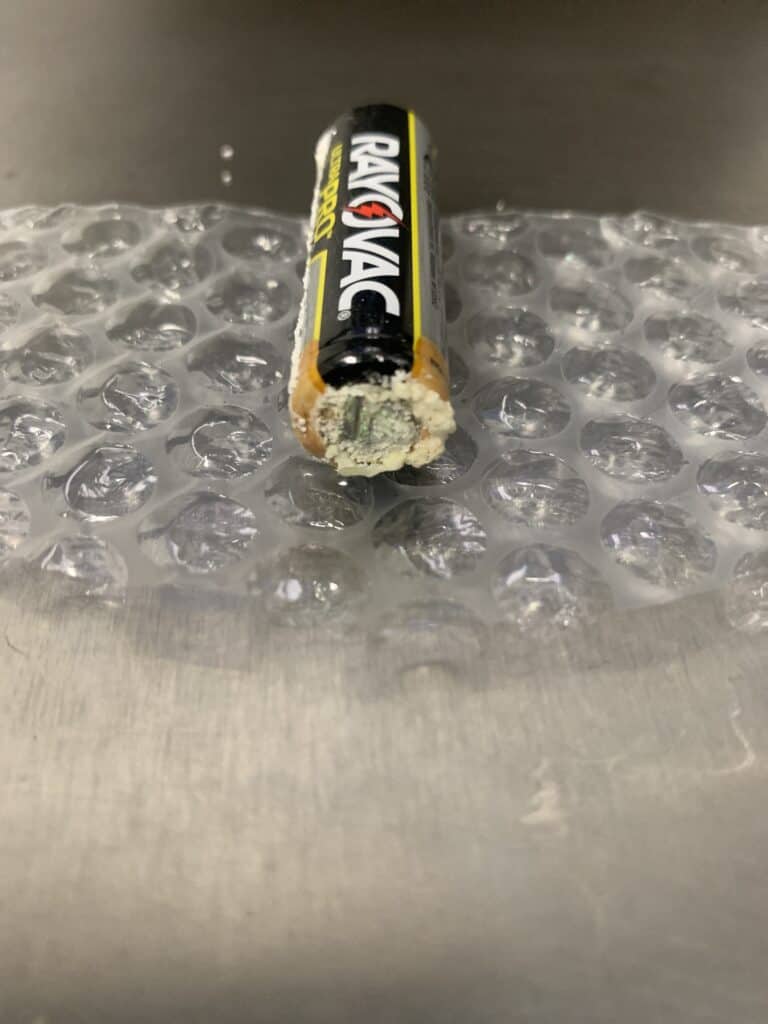Batteries are everywhere in our daily lives, powering everything from our favorite gadgets to essential home appliances. But have you ever noticed a white, powdery substance seeping out of batteries? This article is here to explain that mysterious white stuff, what it’s made of, whether it’s harmful, and how to deal with it properly. Although the white substance from battery leakage isn’t inherently toxic, it needs to be handled carefully and cleaned up using the correct methods to avoid potential harm. Understanding the composition of these substances and how to deal with them effectively ensures both your safety and the longevity of your battery-operated devices.
Battery Leakage: How To Handle
Leaking batteries can be stressful, but don’t worry, a calm approach and proper handling can minimize risks. Here’s a table to guide you through the process:
| Step | Action |
|---|---|
| 1. Assess the situation | – Identify the leaking battery type (alkaline, lithium, etc.). – Assess the severity of the leak (minor, moderate, significant). – Evaluate if the device is damaged or still functioning. |
| 2. Safety first | – Wear gloves and protective eyewear to avoid contact with leaked material. – Open windows and doors for ventilation if leakage is significant. – Keep children and pets away from the affected area. |
| 3. Remove the battery (if safe) | – If possible, safely remove the leaking battery from the device using gloves and tools (tweezers, etc.). Do not touch the leaked material directly. |
| 4. Neutralize the leak | – For alkaline batteries: use a cotton swab dipped in vinegar or lemon juice to neutralize the leaked potassium hydroxide. |
| – For lithium batteries: avoid contact with water as it can generate heat and worsen the situation. Instead, carefully collect the leaked material with a dry, absorbent material (sand, baking soda). | |
| 5. Clean the affected area | – Wipe the device and surrounding area with a clean, damp cloth to remove any residue. Dispose of the cloth and gloves properly. |
| 6. Dispose of the battery and leaked material | – Place the leaking battery and contaminated materials in a sealed plastic bag and dispose of them at a hazardous waste facility or according to local regulations. Do not throw them in the regular trash. |
| 7. Evaluate the device | – If the device is damaged by the leak, do not use it. Get it inspected or professionally repaired. |
Additional Tips:
- Be cautious when handling any type of leaking battery, regardless of its size or type.
- If you experience skin or eye irritation from exposure to leaked material, rinse the affected area immediately with clean water and seek medical attention if necessary.
- Always consult the device’s manual for specific instructions on handling battery issues.
Understanding Battery Leakage
What’s Inside a Leaking Battery?

The white substance often seen in leaking batteries is primarily a result of chemical reactions occurring within the battery. This substance is not inherently toxic but can be caustic, meaning it can cause irritation or burns if it comes into contact with your skin.
Carbon-Zinc Batteries (LeClanche Cells)
In carbon-zinc batteries, the leakage is typically a mix of compounds like manganese hydroxide, zinc ammonium chloride, ammonia, zinc chloride, zinc oxide, and water, combined with starch from the battery’s internal separator. These substances are not toxic and can even be used in fertilizers.
Alkaline Batteries
Alkaline batteries contain similar compounds, but they also have potassium hydroxide, which reacts with carbon dioxide in the air to form potassium carbonate. Although potassium hydroxide is corrosive, it’s absorbed into the battery components, reducing the risk of direct exposure.
Preventing and Treating Battery Corrosion
Battery corrosion often results from the leakage of these substances. It’s essential to handle corroded batteries carefully, dispose of them properly, and clean any residue safely.
Non-Rechargeable Alkaline Batteries
For cleaning up leakage from non-rechargeable alkaline batteries, use white vinegar or lemon juice and a toothbrush. Be sure to protect your skin and eyes during the cleaning process.
Rechargeable Batteries
Leakage in rechargeable batteries, like NiCad and NiMH, can be treated with baking soda to neutralize the potassium hydroxide.
Lithium Batteries
Lithium batteries require special handling due to their combustible nature. If you encounter a swollen lithium battery, it’s best to seek professional help for safe disposal.
How to Clean Battery Corrosion
- Wear Protective Gear: Use gloves and eye protection to avoid direct contact with the caustic substances.
- Remove and Dispose of Batteries: Safely remove the batteries and follow local guidelines for disposal.
- Apply Cleaning Agent: Use vinegar or lemon juice to treat the corrosion. For stubborn areas, baking soda can be effective.
- Scrub and Dry: Use a toothbrush to scrub the affected areas and ensure the battery case is dry before inserting new batteries.
- Prevent Future Corrosion: Store batteries in cool, dry places and avoid mixing old and new batteries in the same device.

Summary of Facts
- The white substance in leaking batteries is usually a mix of chemical compounds.
- It’s not toxic but can be caustic, potentially causing skin irritation or burns.
- Carbon-zinc and alkaline batteries contain different compounds, but neither is inherently toxic.
- Proper disposal and cleaning methods are crucial for handling battery leakage.
- Preventing battery corrosion involves proper storage and care of batteries.
FAQ
What Is the White Powder That Leaks from Batteries?
The white powder is primarily a mix of chemical compounds formed due to the battery’s internal reactions. It can include substances like manganese hydroxide, zinc ammonium chloride, and potassium carbonate.
Is the White Substance from Battery Leakage Dangerous?
While not toxic, the substance can be caustic and may cause skin irritation or burns. It’s essential to handle it with care and protect your skin and eyes during cleanup.
How Do You Clean Up Battery Leakage?
To clean up battery leakage, use white vinegar or lemon juice for non-rechargeable alkaline batteries. For rechargeable batteries, baking soda is effective. Always wear protective gear and ensure proper disposal of the batteries.







